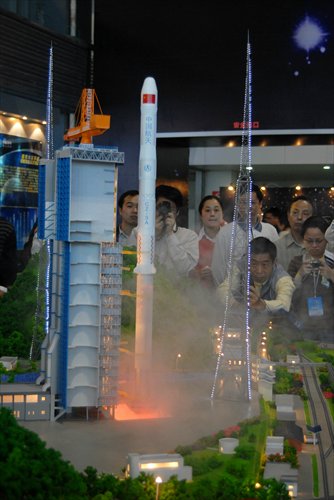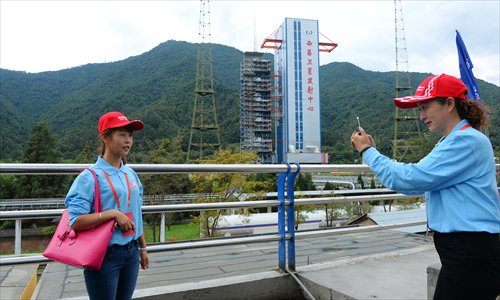Starry-eyed travelers
China’s space centers an ideal getaway for tourists with their heads in the clouds

Visitors behold a replica of the launch pad at the Xichang Satellite Launch Center. Photo: CFP
Around 1,600 kilometers southwest of Beijing, surrounded by the endless expanse of the Gobi Desert in what might be described as "the middle of nowhere," lies the heavily-guarded Jiuquan Satellite Launch Center (JSLC). The remote center has witnessed the launches of more space vessels than any other in China. It was there that China's first satellite, the Dong Fang Hong 1, was sent into space in 1970. It was there that the country's first manned space mission, the Shenzhou 5, departed in 2003, making the nation the third to independently send a man into space after the US and Russia.
More recently, the space station saw the launch of the Shenzhou 9 in 2012, a voyage that sent China's first female cosmonaut beyond the earth's atmosphere.
Covering 2,800 square kilometers, the center is home to as many as 20,000 scientists, researchers and astronauts.
Since 2007, JSLC has been open for public visits. While the areas that can be visited are strictly controlled to protect sensitive information, for most members of the public, such a visit is the closest one can get to being part of a journey to the stars.

The launch of the Chang'e 3 space rover in December 2013 as part of China's lunar exploration program. Photo: Courtesy of Li Heng
Ready for launch
Wang Dan, the general manager of Jiuquan Oriental International Travel Service, has been organizing trips to the satellite center for nearly a decade.
China's first spaceport, JSLC was founded in 1958. Those who wish to visit the center are required to bring their ID cards for security clearance before being admitted entrance to the base, Wang said. At present, only Chinese mainlanders are allowed, with those holding international passports, or passports from Taiwan, Hong Kong or Macau denied entry.
Once cleared for entrance, among the sites visitors can see are the center's launch pad, which towers more than 100 meters high, and the rooms that some of China's cosmonauts lived in while preparing for their flights into space, known as Wentiange.
"It was in that dormitory that our country's leaders watched our astronauts lift off into the space, carrying the country's dreams with them," said Wang.
"On the bedroom doors [of the dormitory], visitors can see the signatures of the astronauts as well as messages they wrote before embarking on their missions to space."
Visitors can also explore the museum at the center and pay their respects at the Dongfeng Cemetery of Martyrs, where more than 600 men and women who have devoted their lives to China's space program are interred.
"The museum shows the development of the center and the evolution of China's space program, from the moment that the very first military personnel arrived on this desolate land and built the satellite center from scratch," said Wang.
"[Back then], the satellite center was just a barren desert with no food, water or any signs of life. The first teams that arrived made tremendous endeavors to build the satellite center, with some losing their lives. There was nowhere for them to sleep at night, so they would just dig holes in the sand to lay their weary heads in."

The region around XSLC is well-known for the diversity of its ethnic minorities, including the matrilineal Naxi people. Photo: Courtesy of Ke Suling
3…2…1…Blastoff!
Perhaps the most exhilarating sight that visitors can witness from the center is an actual space launch.
Although visitors cannot set foot inside the center during scheduled launches, there are specially designated areas, between 3-5 kilometers from the launch pad, from which visitors can sit back and watch a space vessel liftoff.
Wang recalls seeing the Shenzhou 7 spacecraft take off in 2008.
"It's incredibly loud. The building you're standing in and the ground beneath you starts to shake," said Wang.
"After the spacecraft successfully lifts off, people who don't even know each other will start jumping up and down and hugging each other."
"At that moment, I was overwhelmed with pride for our country and for all the people who have dedicated their lives to our space program, and I felt all these feelings rushing to my head, to my heart and to every part of me. I couldn't help but cry," said Wang.
In recent years, JSLC has become a veritable tourist hotspot. In 2011, the year that the Shenzhou 8 unmanned spacecraft was launched, the center received 6.16 million visitors, according to Chongqing Business Daily.
Wang said that even when there are no scheduled launches, her company accommodates around 5,000 visitors every year.
Feng Jin, a 32-year-old woman from Xi'an who visited the center with her family in 2011, said that it was an emotional experience.
"We were all so moved that people could make all of this in such challenging conditions," said Feng.
"My son was also very excited to learn about the space program and its history."
Feng said that those planning to visit the center could pair their trip with other notable tourist spots in the surrounding regions.
"We went to see the Mogao Grottoes [also known as the Caves of the Thousand Buddhas] in Dunhuang, Gansu Province, and Jiayuguan, a part of Great Wall from Ming Dynasty," said Feng.
"There's a lot to see in that area, a lot of history."

A tourist has her photograph taken on a platform overlooking XSLC's launch pad. Photo: CFP
Walk like an astronaut
Hidden in a valley around 60 kilometers away from Xichang in Sichuan Province, the Xichang Satellite Launch Center (XSLC) is the largest space center in Asia, covering around 12,000 square kilometers.
Construction on the satellite base began in 1970, and the center became operational in 1982.
Li Heng, a manager at the Mianning Chang'e Benyue Travel Company which organizes trips to XSLC, said that it was the first space center in China to open its doors to the public, in 1996.
The center is home to the tallest launch pad in Asia, at 168 meters. As at JSLC, there is also an exhibition room showing the history of the center.
"There is even an exhibit where visitors can try on a space suit and sit inside a satellite re-entry capsule, while watching footage of a satellite floating in space," said Li.
"And of course, visitors can view satellite launches from a safe distance when there are scheduled missions."
Unlike JSLC, both Chinese and foreigners are allowed to enter, said Li.
Ke Suling, the founder of LV&LV Youth Hostel which is based near the satellite center, said that there is much to see in the region besides the space station.
The Xichang area is known for its diversity of ethnic minorities, including the matriarchal Naxi and Mosuo peoples, and the Yi people, who are known for their generosity toward guests.
"Yi people are very hospitable. You can just walk into any person's home during Spring Festival, and they will offer you a lot of good food and wine, and you can join their celebration as if it were your own home," Ke said.
In addition, said Ke, there are also a number of scenic spots around the area, including the Luoji and Lu mountains, and the Qionghai and Lugu lakes.
Space base tourism
China's newest space center, currently under construction, is the Wenchang Satellite Launch Center (WSLC), on the island of Hainan in the south of the country.
Perhaps buoyed by the popularity of China's other space centers as tourist destinations, there are plans to build a space-themed amusement park nearby according to a report of the Hainan Daily in 2013.
The theme park will include facilities for visitors that simulate what it is like to be in space, said the report.
Xue Xiangwen, director of the Wenchang Tourism Commission, said in the report that the city is also building more hotels and improving local scenic spots in anticipation of the tourists the space base will bring.
There are currently no details on when the WSLC or the amusement park will be completed.
Feng said she plans to visit the country's other space centers with her family in the future.
"My son is completely hooked on with space stuff," said Feng.
"We want to support his interest to learn more."